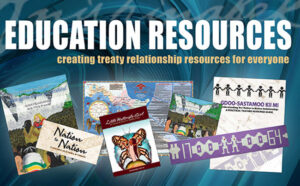Ipperwash Summer Series: Our duty to tell our side of history
September 6, 2020, will mark the 25th anniversary of the shooting death of unarmed protestor Anthony “Dudley” George by an Ontario Provincial Police sniper at Ipperwash Beach. The Anishinabek News will feature an Ipperwash Summer Series to highlight the history, trauma, aftermath, and key recommendations from the 2007 Report of the Ipperwash Inquiry. First Nations in Ontario understood that the Inquiry would not provide all of the answers or solutions, but would be a step forward in building a respectful government-to-government relationship.
For information on the 2007 Report of the Ipperwash Inquiry, please visit: http://www.attorneygeneral.jus.gov.on.ca/inquiries/ipperwash/closing_submissions/index.html

By Marci Becking
My office phone rang on a sunny June morning at the Anishinabek Nation head office in 2015. A month prior, we had just started to send out the first of the “We are all Treaty People” teachers kits out to various First Nations and school boards.
A woman, a teacher, was crying on the other end.
“Thank you so very much for finally giving us something to teach!” she said through her tears of joy. “We can finally bring the treaty relationship into the classroom in an honest and good way. This is a great beginning!”
After her call, I knew we had something that would change young minds in Ontario. If what kids got out of all of this was that a treaty was an agreement still valid today and lasts forever and that there are treaties that cover all of Ontario, then we had accomplished something.
On May 30, 2007, the Report of the Ipperwash Inquiry was released. Just a month earlier, I was hired as a communications officer for the Anishinabek Nation. I remember my mentor and director Maurice Switzer going down to Forest, Ontario, for the release of the Report and its 98 recommendations. It was determined by our organization the key recommendations that we would be pushing for implementation. I remember being naïve thinking to myself, “Don’t they have to implement the recommendations?” Of course not, silly me. And so began an entire “Era of Action” campaign for the Ontario government to implement the key recommendations.
Before this, on his own, Sam George led the charge of treaty education and went around to schools speaking to kids about the importance of learning about treaties. Former Grand Council Chief John Beaucage also did the occasional visit to schools.
“Look out your classroom window,” he would say to students. “This school, streets, sidewalks – this all exists because a treaty was signed.” It would change their worldview.
Our Intergovernmental Affairs Department started working with other Provincial Territorial Organizations (PTOs) and the Ontario Government on various committee themes that came out of the Report: Policing, Heritage & Burials, Communications, Consultation and Accommodation, Resource Benefit Sharing, Recognition and Implementation of First Nation Jurisdiction, Treaty Commission and Capacity Building – Dudley George Reconciliation Fund. You’ll recognize some of these themes in other articles throughout the Anishinabek News Ipperwash Summer Series.
Over time, those committees dissolved, and it was not all Ontario’s fault. When you get representation from the PTOs to work on committees, regional priorities can sometimes take the focus off the end goal.
The focus on our little communications department at the time was public education. Maurice would do speaking engagements and cross-cultural training sessions. He even started up the Niijii Circle Page – a full-page that has been in every Saturday edition of the local newspaper, North Bay Nugget, since 2001 – that educated the public about First Nations people.
Sam and Maurice were doing public education well before the Report recommendations told them to.
In 2011, Maurice wrote, We are all Treaty People, and it became a national bestseller without ever hitting a mainstream bookstore.
Other books by various First Nation authors and illustrators such as Treaties Matter: Understanding Ipperwash, Nation to Nation: A Resource Guide to Treaties in Ontario, Little Butterfly Girl, Alex Shares his Wampum Belt, Dakota Talks about Treaties and the Anishinabek Nation Colouring Book, are all a continuation to maintain public education of First Nation history, people and treaties in Ontario.
Two teachers’ kits came out of these books, which brings me back to my crying teacher.
My son just the week before had said to me exasperated, “Mom, we finally learned that we live in the Robinson Huron Treaty today.” I took that opportunity to tell him that the teachers are learning about this at the same time they are teaching it. I think it was one of those “awakening” moments you get as a kid the first time you see your teacher in public and realize they don’t live at the school.
There were no Professional Development days dedicated to treaty education. Nothing was yet taught as most teachers were obtaining their teaching degree. Sam had passed into the Spirit World in 2009. Maurice, now with his own consulting business, was travelling all over facilitating cross-cultural training and going into schools giving students the opportunity to handle a wampum belt for the first time.
Now we hold teacher training sessions on the teachers’ kits, treaty education sessions for industry and government. There is a place in the Ontario Indigenous Affairs Office called the Maynard Sam George Library that holds over 2,000 resources, including ours. Treaties Recognition Week has been held the first week of every November since 2016.
The Anishinabek Nation continues to create treaty resources – but not because of a recommendation or a partnership with Ontario. We continue to develop treaty education resources for our children and their teachers as our duty to tell our side of history.
Marci Becking is the Senior Communications Officer for the Anishinabek Nation. She has been involved in the development of treaty education resources since 2011.


